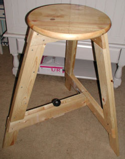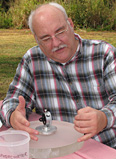Mirror Making Class
- Want the best possible images from your scope?
- Want to save hundreds compared to commercial scopes?
- Have Saturday afternoons free for the next several months?
Consider making your own mirror!
The St Petersburg Astronomy Club Mirror Lab can help.
The Tampa Bay area isn't known for it's good clear skys. We have clouds, rain, haze and humidity to deal with in addition to light polution. As a result we have to make our mirrors better.
For several years the Tampa Bay Mirror Lab has helped young and old learn the art and science of newtonian reflector mirror making. We can show you what we do and how easy it is for you to start making your own optical masterpiece.
The St Petersburg Astronomy Club Mirror Lab offers a year round mirror making class. First time mirror grinders are now recommended to start with 10 inch blanks. (8inch is still acceptable). First timers are also recommended to work towards a focal ratio of f/6 as this is the easiest
Course Description The student will construct a ceramic tiled tool for grinding. Basic grinding techniques to acheive spherical curve will be demonstrated. The making of a pitch lap for polishing and figuring will done for each student. How to perform the Foucault and Ronchi tests. Guidance in the use of software to make Millies-Lacroix plots.
Price: $100
Class Meets every Saturday afternoon from Noon until 4pm.
We are located at the Science Center of Pinellas
7701 22nd Ave N
For more information contact Paul McNabb at 727-345-5713
The Process
Grinding Starting with 60 grit going all the way to 5 micron cerium oxide (CeO) the basic curve is created. Be ready to use your muscles in this step because grinding a mirror is a workout. (11 hours)
Making a Pitch lap After grinding, a new tool is made out of pitch. This is used to polish the mirror smooth.
Polishing This produces a smooth finish on the mirror accurate to at least 1/4 the wavelength of visible light. (Yes, we are that precise!) (8 hours minimum)
Foucault Testing This done concurrently with polishing and figuring. (it only takes a few minutes with our robotic foucault tester)
Figuring It might only take a couple of minutes and a few strokes to turn a spherical mirror surface into a fine parabolic reflector. We've had mirrors come out accurate to 1/20th wave!
Nomeclature
blank aka mirror blank. This is a flat piece of glass, either plate glass or pyrex, that is ground and polished into a telescope mirror.
f/ratio - the focal length divided by the diameter of the mirror. Less than f/5 a mirror is termed "fast" and is good for wide field viewing. More than f/6 and a mirror is "slow" and better for high magnification and planetary work. Through much trial and error we believe f/6 is the most preferred f/ratio.
focal length - measured from mirror surface to a point where a reflected image is formed.
grit size - the number of grains per inch (e.g. 60 grit has 60 grains of silicon carbide per inch) The larger the number the finer the grain.
parabaloid - the perfect shape for a mirror to reflect an image. A spherical shape is naturally formed by the grinding and polishing process. It's a little trickier to deepen the mirror just the right amount to turn it into a parabaloid.
radius of curvature - twice the focal length. This is the radius of an imaginary sphere that the mirror surface conforms to.
sagitta - a fancy term for the depth of a mirror. The sagitta is created by grinding away the surface of the mirror blank.
Plans, Instructions etc...
 |
Portable Grinding Table schematic (pdf format) Allen Maroney came up with this nice set of plans for a portable grinding table. Its a three legged design with a flip top grinding platform. It's very stable and colapses down flat for transportation. |
 |
Sagitta Calculation Sheet (pdf format) Sagitta AKA mirror depth. Measured in thousands of an inch. |
